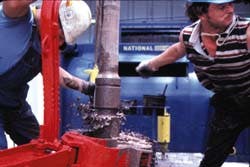Fluid technology paces industry
Fluids research through the years has revealed to operators the negative effects of using drilling or completion fluids incompatible with producing formation chemistry. Proper fluid selection protects the formation during the drilling, completion, and cleanup stages of the well, while the wrong fluid chemistry can inhibit production through via excessive skin damage or fluid invasion that can drastically reduce formation permeability at the near well bore. Beyond pressure and formation damage control and remediation, fluid selections now must consider wellbore stability, shale and clay sensitivities, penetration rates, and countless other subtle and not-so-subtle effects of downhole chemical reactions.
Drilling and completion fluids suppliers have become increasingly adept at targeting individual well problems. Special additives are made available for wells whose geometry or lithology suggest the risk of stuck pipe problems. And additives exist to help release pipe differentially plastered to the side of the well bore. Fluids recipes are dictated by everything from wellbore angle to degree of formation depletion.
Hydraulic fracture fluids have become a science of their own as fracturing has grown to include huge volumes of proppant deposited far from the well bore to increase production from low-permeability formations to relatively small fractures in high-permeability formations for sand control and near well bore, post-perforation cleaning.
A factor of our times has been added to the world of fluids as preservation of the environment becomes a more pronounced issue worldwide. What base mud and what additives are best suited to the surrounding environment are critical. Drilling through an underpressured zone in the American west, for example, requires a fundamentally different chemistry than might the same set of circumstances in the Norwegian Continental Shelf.
One result of the environmental movement on fluids chemistry has been fundamental. At one time all muds were water-based, oil-based, or a combination inverted emulsion. In response to environmental restrictions on overboard cuttings discharge when drilling with oil-based muds, the substitutes, called synthetic, or 'pseudo-oil' muds, were born. They responded to a need to use oil base muds in the high risk world of high-angle drilling and to maintain the high penetration rates associated with oil-based muds while complying with increasingly strict environmental regulation. Where OBMs must be used in a closed, zero-discharge, system, cuttings from synthetic muds may be discharged overboard in many areas (though in some areas where the practice is allowed it is under scrutiny--most notably the UK North Sea). And while synthetics are, by-volume, more expensive than water- or oil-based systems, they are less costly than other muds when their use results in fewer drilling days by virtue of improved penetration rates.
New drilling and completion technologies demand fluids responses. The proliferation during the 1990s of high-angle and horizontal wells have spawned a unique set of responses to the need for non-stick, non-invasive fluids as prospective producing formations must often remain exposed to drilling mud for extended periods of time. And since in high-angle wells the effective circulating density of the mud must naturally rise with measured depth while the fracture gradient of the rock remains essentially the same, the chemistry of invasion, and even lost-circulation, becomes more challenging as reach sections grow ever longer.
As the oil and gas industry expands its drilling and completion theaters, fluids must evolve. The immediate challenges to the fluids chemists lie in deep water and in drilling through subsea salt. In deep water, particularly in the Gulf of Mexico, shallow, flowing aquifers are causing considerable problems for drillers attempting to set conductor pipe and one approach to the problem has been to seek a polymer to act as a water shut off. Drilling and casing through extended salt sections is fraught with danger from the near fluid movement salt is capable of and the ease with which it can be washed out. What part fluids technology can play in the pursuit of these frontiers remains to be see but it will undoubtedly play a part.
As the following fluids survey bears witness, proper fluid selection is as critical and complex a pre-drilling consideration as casing size, bits, or any of the myriad decisions involved in planning a new well.
Copyright 1996 Offshore. All Rights Reserved.

